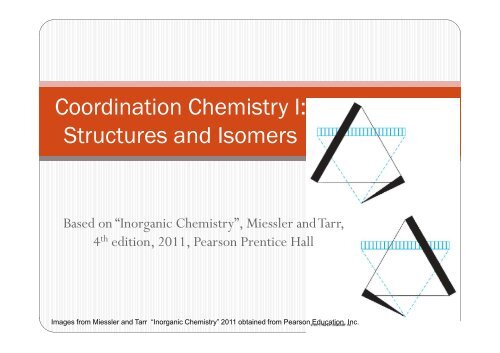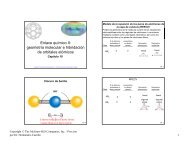Quimica Coordinacion Estructuras e Isomeros Capitulo 9 Miessler ...
Quimica Coordinacion Estructuras e Isomeros Capitulo 9 Miessler ...
Quimica Coordinacion Estructuras e Isomeros Capitulo 9 Miessler ...
Create successful ePaper yourself
Turn your PDF publications into a flip-book with our unique Google optimized e-Paper software.
Coordination Chemistry I:<br />
Structures and Isomers<br />
Based on “Inorganic Chemistry”, <strong>Miessler</strong> and Tarr,<br />
4 th edition, 2011, Pearson Prentice Hall<br />
Images from <strong>Miessler</strong> and Tarr “Inorganic Chemistry” 2011 obtained from Pearson Education, Inc.
Coordination compounds<br />
Term usually used in inorganic chemistry to include<br />
compounds composed of a metal atom or ion and one or<br />
more ligands<br />
Ligands are atoms, ions or molecules that formally donate<br />
electrons to the metal<br />
This definition includes compounds with metal-carbon<br />
bonds, or organometallic compounds
Coordination compounds (cont.)<br />
The term coordination compound comes from the<br />
coordinate covalent bond, which historically was considered<br />
to form by donation of a pair of electrons from one atom to<br />
another<br />
The donors are usually the ligands, and the acceptors are the<br />
metals<br />
Coordination compounds are also acid-base adducts,<br />
frequently called complexes or, if charged, complex ions
History<br />
Prussian blue, aureolin and alizarin were pigments / dyes<br />
known since antiquity<br />
Advances in analytical methodology allowed for the<br />
determination of formulas, and theories of structure and<br />
bonding became possible<br />
But organic chemistry bonding theory was not adequate to<br />
account for the experimentally determined formulas of some<br />
coordination compounds<br />
Hexaamminecobalt(III) chloride – only three other atoms were<br />
“allowed” to attach to cobalt
Jorgensen vs Werner
Werner vs other chemists<br />
This complex was originally prepared by Jorgensen and<br />
Werner was able to resolve it into its two optically active<br />
forms<br />
This complex does not has carbon atoms
Primary vs secondary bonding<br />
Primary bonding required counterbalance ions<br />
Secondary bonding were that of the ligands – now known as<br />
coordination sphere<br />
Current practice considers the coordination sphere more<br />
Current practice considers the coordination sphere more<br />
important so the words primary and secondary exchanged<br />
the significance
Tetrahedral vs square planar
Some facts<br />
Werner’s theory required more bonds than that commonly<br />
accepted<br />
18-electron-rule is useful to account the number of valence<br />
electrons around the central atom<br />
Pauling used his valence bond approach to explain differences<br />
in magnetic behavior by use of either 4s or 3d orbitals<br />
Griffith and Orgel developed and popularized the use of<br />
ligand field theory derived from the crystal field theory<br />
of Bethe and Van Vleck
Nomenclature<br />
Organic and some inorganic ligands are frequently named<br />
using older trivial names rather than IUPAC names, although<br />
IUPAC names are preferred<br />
Ligands can be monodentated (one point of attatchment),<br />
ambidentaded (two mutually exclusive points of<br />
attachment), bidentated (two points of attachment),<br />
tridentated, etc.<br />
Bidentated and multidentated ligands usually are called<br />
chelating ligands because they can from rings
Nomenclature rules<br />
Positive ion comes first, then the negative ion<br />
Potassium hexacyanoferrate(III)<br />
Ion negativo se escribe primero, luego el positivo<br />
Ion negativo se escribe primero, luego el positivo<br />
Hexacianoferrato(III) de potasio
Nomenclature rules<br />
Inner coordination sphere is enclosed in square brackets in<br />
the formula, the metal is written first in the formula but last<br />
in the name<br />
Hexamminecobalt(III) chloride, [Co(NH 3) 6]Cl 3<br />
La esfera de coordinación interna se coloca en “brackets”, el<br />
metal se escribe primero en la fórmula, pero último en el<br />
nombre<br />
Cloruro de hexaaminocobalto(III), [Co(NH 3) 6]Cl 3
Nomenclature rules<br />
The number of ligands is given with<br />
prefixes<br />
If the ligand name is complicated or it<br />
includes a prefix, the second prefix is<br />
used (the one ending with “is”)<br />
Dichlorobis(ethylenediamine)cobalt(III)<br />
Tris(bipyridine)iron(III)<br />
Diclorobis(etilendiamina)cobalto(III)<br />
Tris(bipiridina)hierro(III)
Nomenclature rules<br />
Ligands are named in alphabetical order, according to the<br />
name of the ligand, not the prefix<br />
Earlier rule gave anionic ligands first, then neutral ligands<br />
Tetraamminedichlorocobalt(III)<br />
Amminebromochloromethylamineplatinum(II)
Nomenclature rules<br />
Anionic ligands are given an o suffix<br />
Chloro<br />
Bromo<br />
Sulfato<br />
Neutral ligands retain their usual name<br />
Coordinated water is called aqua<br />
Coordinated ammonia is called ammine
Nomenclature rules<br />
Two systems exists for designating the charge or oxidation<br />
number: Stock system (oxidation number of metal ion as a Roman<br />
numeral) and Ewing-Basset system (charge of coordination sphere<br />
as a “normal” numeral)<br />
Ewing-Basset is used in Chemical Abstracts<br />
In either case, if the charge is negative, the suffix –ate (–ato in<br />
Spanish) is used<br />
Tetrachloroplatinate(II) or tetrachloroplatinate (2-) for the<br />
[PtCl 4] 2- ion<br />
Tetraammineplatinum(II) or tetraammineplatinum (2+) for the<br />
[Pt(NH 3) 4] 2+ ion
Nomenclature rules<br />
Cis and trans designate adjacent and opposite geometric<br />
locations (as in organic chemistry)
Nomenclature rules<br />
Bridging ligands between two metal ions have the prefix μ-<br />
as in μ-amido-μ-hydroxobis(tetraamminecobalt) (4+)
Nomenclature rules<br />
When the complex is negatively charged, the names for some<br />
metals are derived from the sources of their symbols<br />
Tetrachloroferrate(III) for the [FeCl 4]- ion<br />
Tetracloroferrato(III) para el ión [FeCl [FeCl4]- ]-
Isomerism<br />
The variety of coordination numbers in coordination<br />
compounds provides with a large number of isomers, the<br />
number of which increases with coordination number<br />
Our discussion will be limited to isomers with the same<br />
ligands arranged in different geometries; types are:<br />
Hydrate or solvent isomerism<br />
Ionization isomerism<br />
Coordination isomerism<br />
Linkage (or ambidentate) isomerism<br />
Stereoisomerism
Stereoisomerism<br />
cis/trans isomers<br />
Chiral isomers<br />
Different conformation of<br />
chelate rings<br />
Other isomers that differ<br />
only in the geometry of<br />
attachment to the metal<br />
atom
fac/mer Isomerism in 6-coordinate<br />
complexes<br />
Ligands can occupy the<br />
face of the octahedron<br />
or a meridian line
Stereoisomerism
Isomerism – combination of chelate<br />
rings – propellers – Δ and Λ isomers
Multiple Δ and Λ rings and ring conformation<br />
Ligands such as EDTA will form multiple rings<br />
Chelate rings can also adopt different conformations (designated δ<br />
and λ) - we will not focus on them
Constitutional isomerism<br />
Hydrate (or solvent) isomerism<br />
[Co(NH 3) 4(H 2O)Cl]Cl 2 and [Co(NH 3) 4Cl 2]Cl • H 2O<br />
Ionization isomerism<br />
[Co(NH 3) 4(H 2O)Cl]Br 2 and [Co(NH 3) 4Br 2]Cl • H 2O<br />
Coordination isomerism<br />
[Co(en) 3][Cr(CN) 6] and [Cr(en) 3][Co(CN) 6]<br />
Linkage (ambidentate) isomerism<br />
Ligands such as NCS - or NO 2 - which have two attachment points
Experimental separation and<br />
identification of isomers<br />
Geometric isomers are separated with fractional<br />
crystallization<br />
Chiral isomers requires chiral counterions<br />
Best identification method, when crystallization allows it, is<br />
X-ray diffraction<br />
Measurement of optical activity is useful for assigning<br />
absolute configuration to chiral isomers
Coordination number and structures<br />
Overall shape of a coordination compound is the product of<br />
several factors:<br />
Number of bonds<br />
VSEPR considerations<br />
VSEPR considerations<br />
Occupancy of d orbitals<br />
Steric interference<br />
Crystal packing effects
Coordination number and structures<br />
Coordination number 1 is rare, except in ion pairs in gas<br />
phase<br />
Coordination number 2 is also rare, [Ag(NH3)2]+, [CuCl2]-<br />
and Hg(CN)2 are well-known examples with a d10 metal ion<br />
and are linear<br />
Coordination number 3 is likely with d10 metal ions, with a<br />
trigonal-planar structure being the most common
Coordination number and structures<br />
Coordination number 4 results in a tetrahedral or squareplanar<br />
structure; tetrahedral is most common<br />
Square-planar structures, when not imposed by a planar<br />
ligand, occur for d8 metal ions
Coordination number and structures<br />
Coordination number 5 can result in trigonal bipyramid,<br />
square pyramid and pentagonal plane (extremely rare).<br />
The energy difference is small and structures can<br />
interconvert
Coordination number and structures<br />
Coordination number 6 is the most common, with<br />
octahedral geometry the most common<br />
Other structures are trigonal prismatic and antiprismatic<br />
A regular octahedron can be distorted to tetragonal<br />
A regular octahedron can be distorted to tetragonal<br />
structures
Coordination number and structures<br />
Coordination number 7 and higher are not common



